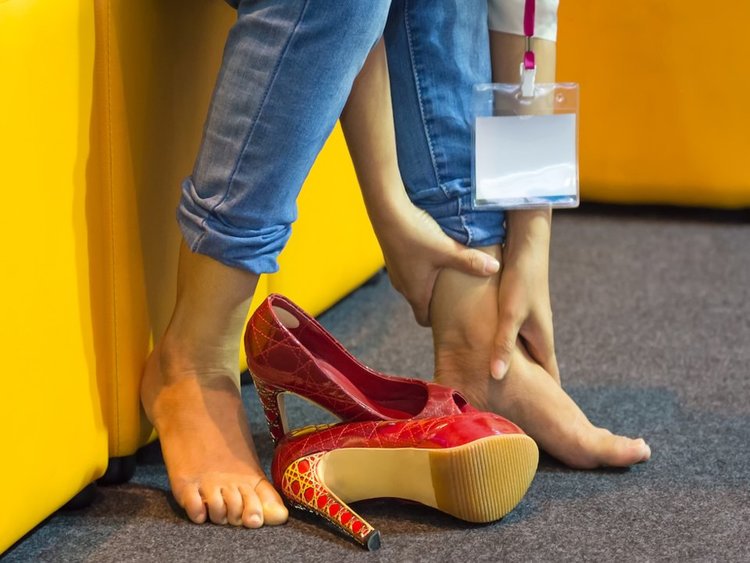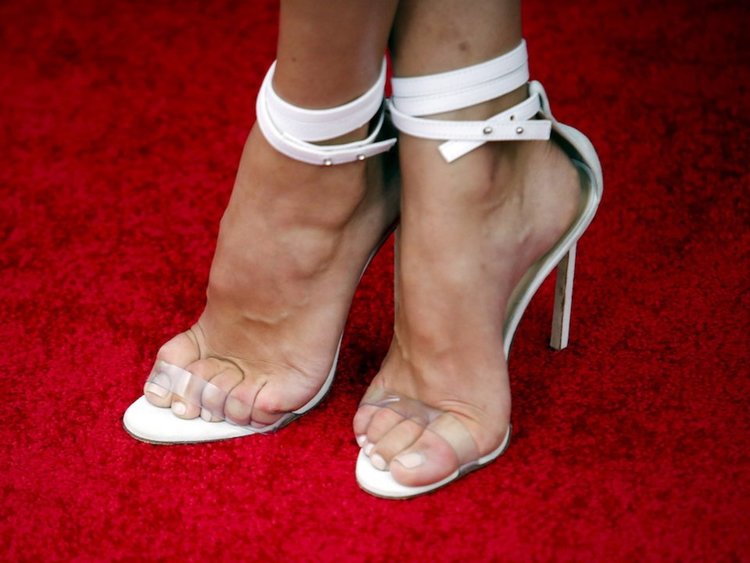Dr. Ragland Featured in INSIDER: 7 Scary Things That Can Happen When You Wear Heels Too Much

Christian Augustin/Getty Images
Wearing high heels can have long-term effects on your feet.
-
Wearing high heels can take a serious toll on your feet.
-
Though heels often aren't the most comfortable footwear option you have available to you, there are plenty of times when no other style will do.
-
Knowing some of the potential effects you're risking when you wear high heels, especially over longer periods of time, and how to potentially ward off some of those effects can help you take of yourself and your feet.
High heels aren't often considered to be the most comfortable shoes in your closet, but sometimes you need or want to wear them. You're likely intimately familiar with the pain and blisters that can (and often do) come along with wearing high heels, but you might not realize that your shoe choice can have a real effect on you beyond just the temporary pain associated with squeezing your feet into the shoes.
If you're going to wear high heels, you need to know not only what sorts of things your choice of shoes might be causing, but also how to help address those issues.
1. You could injure an ankle or end up with stress fractures.
Even if you only have your shoes on for a minute or two, you could potentially hurt yourself.
"[Y]ou could've just put on the shoe and headed out, literally take one step and step on a pebble, and then turn your foot inward and then either strain or break the ligament structures around what we call the lateral side of the ankle — so the outer part of the ankle — and it's called a lateral ankle sprain," Dr. Yolanda Ragland, a podiatrist and the founder of Fix Your Feet, told INSIDER.
You don't have to spend a long time in your heels in order to feel the effects. Though this type of injury probably isn't the very worst thing in the world, it's undoubtedly painful and healing takes time (and sometimes some effort). An injury like this one is a potential for anyone who wears high heels for even a minute or two, but can be especially risky for people who wear heels only seldomly...
Practicing walking in heels — and learning how to do it — might not sound as silly know as it may have before.
2. Arthritis is a real concern.

Wearing heels too often can lead to arthritis.
Ragland said that the joints in your knees or further down into your foot can become arthritic if you wear heels too much because the way that you're compensating while standing or walking can cause the cartilage in these joints to wear down. That's something that you might not consider all that often when determining what sort of shoes to wear or how often to wear high heels, but it's something to keep in mind.
3. You could make existing foot problems worse.
If you already have things like hammer toes, ingrown toenails, corns, bunions, and more, you might notice that wearing high heels can make those things worse.
"[I]f you have bunions or hammer toes, wearing high heels can exacerbate those problems," Ragland said. She added that bunions can grow and become painful more quickly when you're wearing heels versus if you're primarily sticking to flats.

Fabrizio Bensch/Reuters
Wearing high heels can put you at a greater risk of injuring yourself even when you're not wearing them.
Not only that, but you also might notice a bump form (or become a bit worse) on your heels.
"[Y]ou can get a bump that forms because the shoe is rubbing on the back of the heel, which is the calcaneus, and your Achilles tendon inserts into that area, so what happens is that, because you are shortening the Achilles tendon while you are in heels — so it's kind of like it's giving a little bit of relief of strain on the Achilles tendon, but it's also bad at the same time because now it's leaving that bone vulnerable — and you can get a bump on the side and the layman's term is called 'pump bump' and we call it, in medical terms it's called a haglund deformity," Ragland explained.
4. You could experience pain in your body beyond your feet.
Wearing high heels doesn't just affect your feet, but it can make things uncomfortable elsewhere in your body as well... This is at least partially because of the way you carry yourself when wearing heels, which is different than the way you carry yourself when you're wearing flats...
5. You walk differently.
Because you carry yourself differently when you wear high heels and your center of gravity changes, it makes sense that you might walk differently as well...
6. Your toenails can be affected too.
"So, a lot of times ladies come in and they think that they have a fungal nail because the nail looks dystrophic or it looks strange, it doesn't look like it did before," Ragland said. But what actually is happening is that your toenails are "traumatized" because of the contact with the high heels.
Beyond the way that high heels can make your nails look, they can also affect the way that they grow. Ingrown toenails are yet another potential hazard that can come with wearing high heels too much, especially if you're wearing heels with an exceptionally pointy toe, Ragland said.
7. You could end up with hammer toes.
"[W]earing shoes and having hammer toes at the same time will increase your chances of having corns on top of those hammer toes because again, the joint is bending, it's rubbing up against the shoe, the skin wants to protect itself, actually, it has two options: it can either protect itself and form a callus, which is the lesser of the two evils, or it can break down and ulcerate, so the wiser thing that your body does is form the calluses and that's where the corns come from hammer toes," Ragland explained.

Heels can lead to hammer toes and ingrown toenails.
You could still get hammer toes even if you don't wear heels, she said, but your chances of getting hammer toes or dealing with hyperextended toe joints and the potential for dislocated toes may be higher if you wear them.
There are some things that can be done to help prevent or care for these issues.
Luckily, you don't just have to live with it, nor do you have to eschew your favorite pair of heels. In fact, Ragland doesn't discourage patients from wearing heels.
"I think as long as you do things in moderation, you should be fine," Ragland said. "So I don't really discourage people from wearing heels, but I do encourage people to wear their shoes wisely."
That means not wearing them for too long of a period of time if it's not necessary, stashing a pair of flats in your bag to throw on when needed, and wearing a different pair of shoes while in transit, for example.
Ragland... recommended stretching as well. Ragland said that everyone should be stretching every day, whether they wear heels or not...
There are a ton of different techniques and tips that you can use to make wearing heels not only more comfortable, but also slightly less harsh on your body. Still, knowing what kinds of things you might be in for can help you prepare ahead of time and quickly react if something goes wrong.
Big thank you to Lauren Schumacker, author of this great piece! Read the full story on INSIDER.
